Skip over navigation
Article by Toni Beardon

When we check $YG$ we find $YG=GY$ and the group is shown in the seventh illustration above. This combination also introduces a rotation about a line through the axis of the cylinder and perpendicular to the axis (the same type as $R$ shown in the fourth illustration). The seventh group is $\{I, Y, G, R\}$.
This discussion does not constitute a rigorous proof that there are only seven types of frieze group but when considering the cylinder it becomes intuitively obvious. A complete proof based on the symmetries of a cylinder, much simpler than the usual published proofs, can be given using 3 by 3 matrices in 3-space or using mappings in the complex plane.
In summary the seven frieze groups corresponding to the groups of symmetries of a cylinder with the transformations as defined above are :
(1) $\{I\}$ giving the frieze pattern ppppppppppp
(2) $\{I, X\}$ giving the frieze pattern EEEEEEEEE
(3) $\{I, Y\}$ giving the frieze pattern pqpqpqpqpqp
(4) $\{I, R\}$ giving the frieze pattern pdpdpdpdpdp
(5) $\{I, X, Y, R\}$ giving the frieze pattern HHHHHHHH
(6) $\{I, G\}$ giving the frieze pattern pbpbpbpbpbpbp
(7) $\{I, Y, G, R\}$giving the frieze pattern pqbdpqbdpqbd


Or search by topic
Number and algebra
Geometry and measure
Probability and statistics
Working mathematically
Advanced mathematics
For younger learners
Age 11 to 16
Published 2010
Paint Rollers for Frieze Patterns.

Tile pattern
from Palacio de Velazquez, Parque de Retiro, Madrid, Spain
Frieze patterns are formed by repeating
copies of one small bit of the pattern (the motif) over and over
again by translation, rotation and reflection. The identification
of the symmetries in the pattern (the transformations which map the
pattern into itself) is independent of the motif. All frieze
patterns involve translations in one direction only and patterns
involving translations in two directions are called wallpaper
patterns. Classification of these symmetries using group theory
shows that there are exactly seven frieze patterns and seventeen
wallpaper patterns.
|
This article provides an introduction to the classification of
frieze patterns by reducing the problem to studying the symmetries
of a cylinder. It will be an advantage if you have never met frieze
groups but in any case pause now and think about all the symmetries
of a cylinder that you can visualise.
It is intuitively obvious that the cylinder can be used as a
paint roller so that if a pattern is embossed on it, the pattern
can be transferred to paper by repeating it over and over again in
a strip with each revolution of the cylinder. Conversely, given a
frieze pattern on a piece of paper one can wrap the paper around a
cylinder of a suitable radius in such a way that the pattern is
produced once and only once on the cylinder. For the purposes of
this work we consider symmetries of the cylinder other than those
involving rotations about the axis of the cylinder which would
correspond to the frieze pattern being copied more than once on the
surface of the cylinder.
|
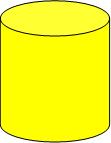 |
| Frieze patterns and wallpaper patterns occur in the art of many
cultures and there is often evidence of exploration of the
different possible symmetries. Escher's work was influenced by the
frieze and wallpaper patterns he saw on a visit to The Alhambra in
Granada, Spain. Some Japanese patterns have to be
matched in pairs in one of the NRICH challenges, an NRICH article
investigates frieze patterns
in car tracks and here is an article by Heather McLeay
on frieze groups illustrated by her photos of cast iron railings
taken all over the world. |
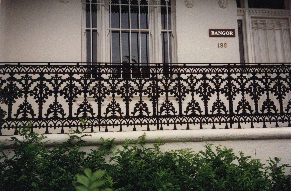 Photo by Heather McLeay Photo by Heather McLeay |
The Frieze Tree
article provides a systematic way to distinguish one frieze
group from another.
We are going to
illustrate the seven frieze groups using patterns on a cylinder.
With only one footprint on the cylinder the patterned cylinder can
only be mapped to itself by the identity transformation $I$. This
is the simplest frieze group and the corresponding frieze pattern
is made up of repetitions of one footprint as if made by someone
hopping along.
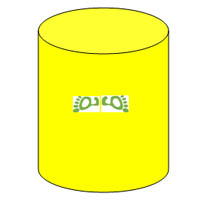 |
With the footstep pattern on the cylinder shown here the only
symmetries are the identity transformation and reflection in a
plane containing the axis of the cylinder. Suppose you denote this
reflection by $Y$ then $Y^2=I$ and the group is $\{I, Y\}$.The
group operation for all the groups referred to in this article is
combination of the transformations and for simplicity we simply
refer to the groups by giving the set of elements.
|
Imagine printing a frieze
pattern using this cylinder as a paint roller and compare the
pattern to the frieze at the top of this article. Of course there
are infinitely many other groups consisting of the identity and one
reflection in a vertical plane through the axis of the cylinder but
because they all have an identical structure (isomorphic groups) we
classify them as one type.
A set of symmetries of an
object becomes a group when the set contains all the combinations
of symmetries within the set. We aim to find all the groups of
symmetries of the cylinder other than the infinitely many groups
involving rotations about the axis of the cylinder.This is a
similar challenge to Rose
which you may like to try before proceeding.
Ignoring rotations about
the axis of the cylinder, before you read on, draw other patterns
on cylinders to show different sets of transformations that map the
'patterned' cylinder onto itself. Each time list all the symmetries
(rotations, reflections and glide reflections) and the combinations
of the symmetries that form a group. How many can you find?
It may help to think of
the different patterns you can make with footprints including the
walking pattern (glide reflection). Remember that, when you make a
print from one revolution of the cylinder, you must not introduce
translations.
|
This pattern involves a reflection $Y$ in a plane through the
axis of the cylinder and a reflection $X$ in a plane perpendicular
to the axis. The corresponding group must contain the combined
transformation $XY$. Can you see that $XY$ and $YX$ both give a
rotation about a line perpendicular to the axis of the cylinder? We
shall call this rotation $R$. Further checking reveals that
$X^2=Y^2=R^2=I$, $XR=RX=Y$ and $YR=RY=X$ so this frieze group is
$\{I, X, Y, R\}$. Combining any number of the transformations $X$,
$Y$ and $R$ in any order will always reduce to this group of four
elements.
There are simpler groups $\{I, X\}$ and $\{I, R\}$ but as soon
as we include two of the transformations $X$, $Y$ and $R$ we get
all three transformations in the group. While there is only one
group of the type $\{I,X\}$ there are many identical in structure
(isomorphic) to $\{I, R\}$.
|
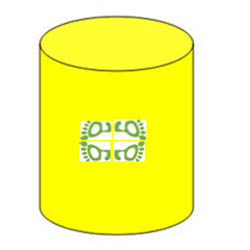 |
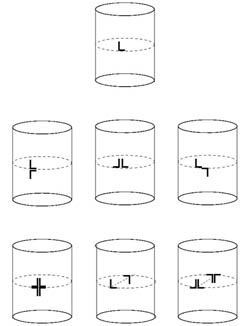 |
We have now described five types of group depicted in the
first five illustrations here which use a simpler motif than the
footprint. The remaining groups involve glide reflections. The
group shown in the sixth illustration is the group involving the
identity and a glide reflection $G$ where $G^2=I$ so the group is
$\{I, G\}$.This is the footprint pattern for someone walking on the
beach.
We have already checked what happens when we form any
combinations of $X$, $Y$ and $R$ with each other and discovered
that they yield only five possible frieze group types.
It remains to check what happens when we combine $G$ with $X$,
$Y$ or $R$ and to discover how many additional groups this
gives.
First check $XG$. This gives a translation half way around the
circumference of the cylinder so it is ruled out as one of the
acceptable frieze group types because when printed it would give
two translations with one revolution of the cylinder.
|
When we check $YG$ we find $YG=GY$ and the group is shown in the seventh illustration above. This combination also introduces a rotation about a line through the axis of the cylinder and perpendicular to the axis (the same type as $R$ shown in the fourth illustration). The seventh group is $\{I, Y, G, R\}$.
This discussion does not constitute a rigorous proof that there are only seven types of frieze group but when considering the cylinder it becomes intuitively obvious. A complete proof based on the symmetries of a cylinder, much simpler than the usual published proofs, can be given using 3 by 3 matrices in 3-space or using mappings in the complex plane.
In summary the seven frieze groups corresponding to the groups of symmetries of a cylinder with the transformations as defined above are :
(1) $\{I\}$ giving the frieze pattern ppppppppppp
(2) $\{I, X\}$ giving the frieze pattern EEEEEEEEE
(3) $\{I, Y\}$ giving the frieze pattern pqpqpqpqpqp
(4) $\{I, R\}$ giving the frieze pattern pdpdpdpdpdp
(5) $\{I, X, Y, R\}$ giving the frieze pattern HHHHHHHH
(6) $\{I, G\}$ giving the frieze pattern pbpbpbpbpbpbp
(7) $\{I, Y, G, R\}$giving the frieze pattern pqbdpqbdpqbd
You may also like
2001 Spatial Oddity
With one cut a piece of card 16 cm by 9 cm can be made into two pieces which can be rearranged to form a square 12 cm by 12 cm. Explain how this can be done.
Screwed-up
A cylindrical helix is just a spiral on a cylinder, like an ordinary spring or the thread on a bolt. If I turn a left-handed helix over (top to bottom) does it become a right handed helix?

